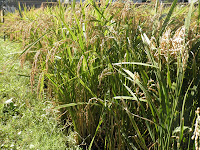
Oct. 28, 2009
Japan’s food self-sufficiency and fate of rice
Rice was always close at hand to Japanese people since the ancient times. The annual plant, which originally came from the Indochinese Peninsula, has continued to support people’s food life in the land which became to be known as Japan and formed a part of its traditional culture.
Japan was called the Land of Golden Ears of Rice in the Japanese myths.
Rice, ine in Japanese or called kome as a grain, is among the so-called five major cereals, which also include wheat, millet, foxtail millet and barnyard grass, but it is far more important than any other grains. A mythical episode says that a goddess named Ohgetsuhime produced the seeds of rice and wheat, and adzuki bean and soybean as well as silkworm from various parts of the body when she died.
Rice is in the ear and leaning in one direction in the autumn field.
I want to lean on your love in despite of bad rumor about us.
Bad rumor about our love bitterly pierces my heart.
I have never done this before in my life,
but I will wade across a river at dawn to see my lover.
(Personal translations)
These are poems composed by Princess Tajima, who left a few poems about her unforgivable love with Prince Hozumi, her half brother, in Manyoshu, Japan’s oldest waka poem collection. The year of her death is unknown, but she was believed to be in her late 20s when she died in 708. Prince Hozumi went out in heavy snow one day to visit the grave of Princess Tajima. He made the following elegy while having a distant view of her tomb on a hill in Yonabari, a mountainous area which was to the south of her former residence near the Imperial Palace:
She must be feeling cold.
Snow! Please do not fall so heavily on Ikai Hill of Yonabari.
(A personal translation)
Paddy rice blooms tiny white flowers from June to July. When it bears fruit, the ears droop down due to its weight.
Many of Japan’s traditional festivals are linked to rice as people continued hard efforts over the centuries to increase rice paddies by cultivating wasteland, controlling river flows and building irrigation canals. Farmers held festivals from spring to autumn while praying for and thanking for a bumper harvest for rice, not other grains. Rice was important not only for Japan’s food life. It was also an indispensable, pivotal product for economic activity until the end of the Edo Era. The rice-oriented economic system in the period led to the launch of a rice futures exchange in Osaka, the commercial hub of western Japan, in 1730. This was the first futures market in the world.
Rice is the staple food for Japanese people now. Rice has been so important a part of Japan’s society and tradition, but its fate is far from certain at present. The environment is becoming more serious than before for rice growers amid a continuous oversupply and declining prices, while consumers’ preference for food is diversifying.
Rice has been a politically touchy issue in the recent decades amid pressure from abroad to open Japan’s heavily protected rice market to imports. But Japan’s policymakers believe that measures should be taken to continue Japan’s rice production in order to maintain Japan’s food self-sufficiency and food security. They also believe that rice farming has numerous functions to play, preserving the natural environment and maintaining the rural community. Japan’s food self-sufficiency is picking up in recent years, but it remains as low as around 40 pct.
The Democratic Party of Japan, which has come to power after a recent election victory, has made clear a policy of introducing a producer-specific subsidy system initially for rice to cover a gap between rice prices and costs. But opponents and experts doubt if the system will work well, warning it may rather invite a moral hazard among producers. Japan is expected to need more time to find an effective prescription for saving Japan’s rice farming and making its rice and rice farmers internationally competitive.
